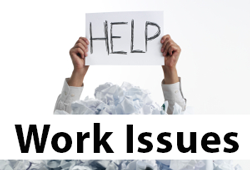What is Bullying?
Bullying is one of the most harmful forms of workplace conflict.6 Bullying should never be tolerated, but it can be hard to recognize. How can you tell if bullying is going on in your call center?
A few key factors distinguish bullying from other kinds of conflict. Hover over each factor to learn more.
- Bullying is repeated.
- Bullying is targeted.
- Bullying is unreasonable.
It can take the form of:

Repeatedly using offensive or abusive language to a coworker is bullying.

Spreading rumors or repeatedly speaking behind a coworker's back is bullying.

Setting unreasonable tasks or deliberately inconveniencing a coworker is bullying.
Is This Bullying?
Taryn and Denise don't like each other. After a few heated arguments, they now won't use the break room if the other one is there. Employees have been complaining that their behavior is causing people to take sides and making the workplace tense for everyone.
The answer is no.
This situation isn't great, but Taryn and Denise aren't bullying each other because they are both being equally unfriendly. Bullying goes in one direction, with one person or group targeting another for bad treatment.
Is This Bullying?
Dan, a new hire, has been a little slow to learn the ropes. He asks a lot of basic questions and has a loud and nasal voice. Mocking his questions has become a popular activity, and a 'What would Dan do?' thread on social media has everyone giggling.
The answer is yes.
The employees who are mocking Dan are targeting him for bad treatment and repeating the insulting behavior over a period of time. This humiliating joking is not something Dan should reasonably have to endure.
What Can You Do?
Use this checklist to recognize the risk factors for bullying.7 Minimize these factors as much as you can. But if any of these are present, pay close attention and be ready to deal with bullying problems if they do arise.
| Risk Factor | Ways to Help | ||
| Organizational change | Prioritize openness and communication. Employees should have as much support and security as possible during times of organizational change. | ||
| Negative leadership style | Provide leadership training, mentorship, and ongoing feedback for trainers, supervisors and all others in leadership roles. | ||
| Gaps in work systems | Clearly define roles and responsibilities, policies and procedures, and ways of managing resource shortages—and stick to them. | ||
| Negative workplace culture | Focus on fairness and consistency. Consider training and other team-building interventions to help improve relationships. | ||
| Vulnerable employees | Invest in diversity and tolerance training. Set up support and mentoring systems for employees who might become bullying targets. |
Other Ways To Recognize Bullying Early
- Pay attention to social dynamics (in-groups and out-groups, gossip, and workers who may be excluded).
- Regularly consult with workers one-on-one to “take the temperature” of the social environment.
- Ask about bullying in exit interviews with workers who choose to leave.
- Check in with other managers, trainers, and supervisors.
- Monitor incident reports, workers compensation claims, patterns of absenteeism, sick leave, staff turnover and records of grievance to establish patterns of sudden unexplained change.
A final note: Bullying should never be justified by saying “Oh, they're just abrasive with everybody.” Bullying is not a personality trait. It is a behavior that can and must be controlled for a work environment to function healthily.
